The 6 Most Unintentionally Hilarious Superhero Reinventions
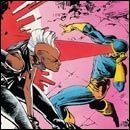
There are comic book characters that have successfully been reinvented over the years, like Superman (originally couldn't fly), the X-Men (originally sans Wolverine) and Batman (originally a cricket-themed adventurer). In all those cases, however, the writers and artists were always respectful to the core of the character, since that's what made them popular in the first place -- changing that would be stupid, because then you might as well create a new character.
Which isn't to say that it hasn't happened. Like in ...
Groovy Kung Fu Wonder Woman

Even though her creators gave her a horrible sexist superhero weakness, Wonder Woman is still a pretty big deal -- if this were a list of the 10 most recognizable superheroes ever, she would not only be there, but also be the only woman.

If this were a list of the superheroes whose live action TV shows we've masturbated to, it would be her and Batman.
Part of the appeal is that the Wonder Woman concept is pretty straightforward: She's a powerful Amazon sent to the world of man to fight crime. It's that simple. Also she owns a magic lasso and an invisible airplane.
The WTF Reinvention:
All that stuff was tossed aside between 1968 and 1973, when DC Comics decided to update Wonder Woman as a hip kung fu private detective without powers. Or a costume. Or, you know, anything else that might justify the use of the words "Wonder Woman" on the cover.

"You dig this diggity dig diggeroo, hepcat? It's the '70s, by the way."
Though DC was probably trying to cash in on that whole "feminism" thing with this move, it all happens because of a guy: In Wonder Woman #179, her boyfriend Steve Trevor (the male Lois Lane) gets in serious trouble and she has to help him -- meanwhile, the Amazons announce they are leaving for another dimension and that Wonder Woman must come with them if she wants to keep her powers. Knowing that Steve would die within two days if left to his own devices, WW gives up her costume and Amazonian abilities to stay with him.
Luckily, she's not helpless for very long because she immediately runs into a blind guy called I Ching who teaches her kung fu.
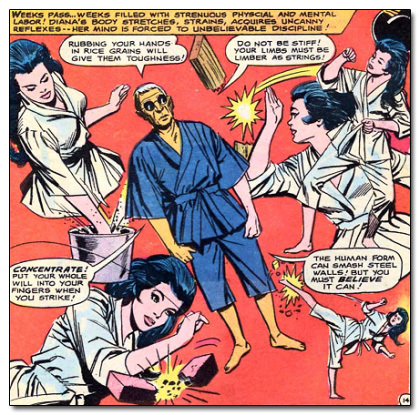
"The secret to kung fu is -- holy shit why is my left arm Caucasian?"
A short training montage later, the new Wonder Woman is ready to go back to helping Steve ... but then Steve dies anyway, because let's face it, he was a moron. Even though her dead boyfriend was the entire reason that she didn't go with the Amazons, Wonder Woman doesn't even think to follow them into the other dimension. Instead, she opens a mod boutique, becomes a part-time private eye and starts traveling the world with her kung fu master.

"I've forgotten why I decided to become a superhero!"
In one adventure, she fights a gang of lesbian hippie child-slaving jewel thieves, probably as a result of the editor asking for a story "ripped from the headlines" and the writer literally combining several news items together. It's like they were so desperate about doing topical comics that they completely forgot about the "doing Wonder Woman comics" part. In most of these issues the name Wonder Woman isn't even mentioned outside the cover, since the whole time she went by her alias, Diana Prince.
Ironically, the same feminist movement that DC had clumsily been trying to appeal to was responsible for Wonder Woman going back to normal five years later, when an offended Gloria Steinem began a public campaign to reinstitute her classic costume and powers. DC quickly printed a story where I Ching is killed and Wonder Woman gets hit in the head and loses her memory of the past five years, soon wandering back into Amazon island and into her old duds. Presumably her martial arts expertise was reverted at this point as well, because none of this was ever mentioned again.

Sadly, the secret to Fafhrd's man-girdle is forever lost to time.
Angel Punisher

Just about every superhero has some kind of strict moral code, usually regarding murdering their enemies (they're against it). Comics writers put the moral code in to keep our heroes likable, and to prove that they're better than the murderous, costumed villains they fight.
But comics writers were allowed one guy. One hero who was going to look and act like a villain. A guy whose only power was that he was crazy and had lots of guns. No code. No moral hang-ups. Just a "murder the bad guys" kinda guy. That hero is the Punisher.
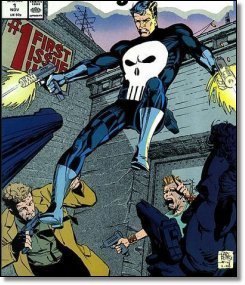
"With great power comes great shooting everyone in the goddamn face."
It's the one totally irresponsible mainstream comic where all bets are off and everyone dies. It's awesome.
The WTF Reinvention:
In 1998, to freshen up the character (???), Marvel decided to have Frank kill himself (???).
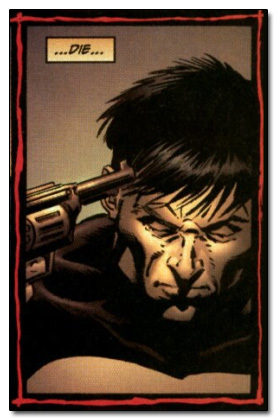
"I've just killed everyone already. Got shit else to do."
And things just went downhill from there. All because someone thought it wouldn't be that much of a stretch to turn Punisher into a gun-slinging angel.
In this miniseries, the Punisher is brought back to life by Gadriel, a guardian angel who decides to give this mass killer a shot at redemption -- which in this case means handing him angelic weapons and sending him off to kill demons. His new job also gives him invulnerability and heightened senses, at which point he stops being the Punisher and becomes a male version of Buffy the Vampire Slayer.

"Anyone else getting a migraine?"
While Frank's magic glowing guns can kill common criminals, during the course of this series he mostly uses them to fight the hordes of hell in order to fix his karma and have a chance of seeing his family again in heaven. This is the sort of bullshit premise that could have only come from the mind of a coke-fueled TV executive pitching a toy-friendly Punisher animated series where they don't actually show him killing people, and yet it was written and published by Marvel Comics themselves.
At the end of the miniseries, the Punisher winds up as a sort of guardian angel himself, drawn to helping out people who need it instead of just blowing the heads off of criminals. And when he does come across criminals, he now gives them a chance to repent and walk away before dispatching them, the most blatantly out of character part of the whole mess.

Why would angel guns need horns?
Apparently being some twisted, angelic disciplinarian with guns was supposed to make the character more likeable, but again, that's not what the Punisher is about. This run completely undermined the intent of the character who had the simplest goal of any superhero ever ("Kill all the things"). After one more miniseries of this same shit (this time guest-starring a very confused Wolverine), Punisher was brought back to normal. Thankfully it only took the next writer a few panels to fix all the damage.


Professor Hulk

From his inception, the Incredible Hulk has always been about a normal man (Dr. Bruce Banner) struggling with his inner demons, which are represented in the form of a green monster with a fondness for purple pants.

We'll discuss the levitating, double-amputee Hulk another time.
Central to the story was Banner being forced to live like an outcast while hiding from the military, which proved tricky given his tendency to grow large and smash things whenever he became upset. It's that paradox that made the stories interesting -- that and all the cool mindless violence.
The WTF Reinvention:
In 1991, however, Marvel did a story where Banner gets his shit in order and, through hypnotherapy sessions, cures himself of his anger issues ... leaving him as an 8-foot-tall green-skinned science professor. So not only can the Hulk form coherent sentences now; perhaps most offensively, he also wears full clothes.
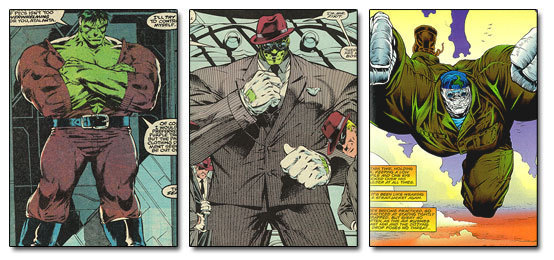
Stan Lee must be spinning in his $100 bill Jacuzzi.
But such a dramatic reversal of the character's very core couldn't last for long, right? Actually, it went on for eight years, with Banner staying in his Hulk form the whole time since there was really no reason to turn back into a skinny little nerd anymore. Not only that, Hulk also turned into a full-fledged superhero, joining a philanthropic organization called the Pantheon and eventually becoming their boss.
Obviously, Hulk's new social status required him to class up his act even more:

Thirty tailors died constructing that suit.

So yeah, he wasn't really the Hulk anymore in the traditional sense. He could still smash a tank pretty good, but preferred using his brain before his massive fists. More importantly, he no longer found himself in that sort of situation as often as he used to. One storyline was completely centered on Professor Hulk dealing with the fact that a close friend had contracted AIDS -- which was a great way to raise awareness and all, but not exactly the kind of drama you picture when you pick up a comic with a giant muscular abomination on the cover.

"KIDS BUY HULK COMICS FOR TENDER PATHOS!"
But wait, if he's that muscular giant when he's feeling calm, what happens if he gets really, really angry? Well ...
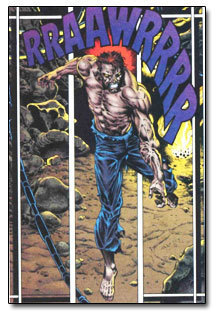
Why are his pants torn?
Eventually Professor Hulk was revealed to be just another split personality (which they seriously called "Professor Hulk"), meaning that Banner was never really cured at all. It took his savage version 15 minutes to ruin all his good work and punch things back to normalcy.
Punk Storm

Storm is one of the X-Men's most popular mutants (after Wolverine, Wolverine, Nightcrawler and Wolverine) and also one of the most powerful, due to her incredible ability to control the weather.

She's most helpful when clearing scary freeway fog.
Originally, Storm was treated as a goddess in her native Africa due to her powers and benevolence, and even after joining the X-Men, she retained that serene, majestic and somewhat naive quality. She's one classy lady, is what we're saying.
The WTF Reinvention:
What happens when you combine Storm, punk rock and (we're not shitting you here) Mr. T?

Likes: The Sex Pistols. Dislikes: Fools.
Chris Claremont, the writer of the X-Men at the time, decided it was time to give Storm a new haircut. Then, as a joke gone horribly wrong, the artist did a sketch of Storm with a Mr. T look, since this was the '80s and the guy was everywhere. To the artist's shock, the editor liked that look and forced him to include it in the comic, despite him arguing that it was a "monstrously bad idea."
As any accomplished anthropologist will tell you, fool-pitying naturally follows the mohawk wherever it grows, and Storm was no exception. Storm simply said screw it and proceeded to start taking on whole gangs with her bare hands just to show how badass she could be.

Also, at some point she became a Drow.
The change was completed a few months later when she was hit by a ray gun that stripped her of her powers. This would be no big deal, except that the whole point of being in the X-Men is that the characters are mutants. It's the number one criteria for joining and staying. But not only does Storm stay, she challenges a fully powered Cyclops to a fight for the role of team leader.
And wins.

And a single lava tear rolled down his cheek.
Imagine recruiting this sweet, humble foreign girl and watching her slowly transform into Clubber Lang. We're guessing the other X-Men were too afraid of her to say anything at this point, powers or not.

Professor X, from a distance, closes one eye and mimes squishing Storm's head, his only recourse.
Once the '80s were over and T-mania ran its course, Storm slowly reverted into her original personality. Just in case, no one's allowed to watch Rocky III at the Xavier Mansion since then.
The Robotic Shadow

The Shadow was Batman before Batman: cool, mysterious, dressed in black and with a talent for terrorizing criminals. The Shadow had unnatural powers, a distinctive costume (cloak and fedora) and a suave playboy secret identity.
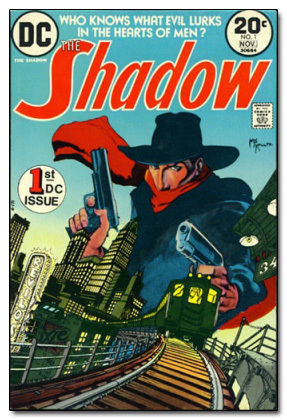
And a train boner.
However, with the Shadow it was never about the superpowers -- he was always fond of firearms, but more often than not he defeated his enemies simply by messing with their heads until they surrendered (and THEN he shot them).
The WTF Reinvention:
And then they turned him into a giant robot:

Who has enough chrome to outfit every Mercedes in Compton? The Shadow does.
By the '80s the rights to publish official Shadow stories had fallen on DC Comics, who clearly had no idea what to do with the guy (they already had a Batman). DC decided to update the character to the present era, which meant replacing his iconic handguns with Uzis and rocket launchers, for instance. Also he drove a flying car.

Apparently the "present" setting was as poorly researched as the past would have been.
As the series progressed it became increasingly bizarre and ridiculously violent -- getting to the point where at the end of a regular issue without any warning, this happened:

"Also, uh, Spoiler Alert, we guess."
But superheroes never stay dead for long. Six months later DC finally brought back the Shadow ... as a disembodied head. Turns out his inept and offensively yellow-skinned sons, Hsu and Chang (created for this series), had stolen his casket in order to bring his body to the mystical kingdom of Shambala where it could be resuscitated, but in the process managed to misplace everything from the neck down.

"-- hang on, am I a fucking head?!"
At this point the comic was barely recognizable as a Shadow series anymore, but it was about to get even worse. Left with no other choice, the scientists/wizards at Shambala place the Shadow's head on a muscular robotic body they happened to have lying around. Shadow adjusts to this change surprisingly fast and is soon ready to leap back into action.

"Shaaaadooooooow!"
The new robot body can zap power bolts from its hands and is equipped with all sorts of weapons, gadgets and Terminator-like kill-vision, which the Shadow uses to literally annihilate an army of around 200 thugs in the space of four pages.

None of them thought to, y'know, aim at the head.
And Shadow stays this way. In the last page a new story line is announced in which the Shadow will battle his oldest enemy, Shiwan Khan, also a cyborg now for some reason.

Machine-gun nipples come standard on all new-model robot torsos.
Anyway the comic was abruptly canceled after this story.
Captain America Becomes Captain ... Nothing

Here's everything you need to know about Captain America:

Yeah, the flag getup pretty much says it all, and also the fact that he's punching Nazism in the face -- not just Hitler, but the actual concept of Nazism. Reportedly, the moment the artist finished drawing this page, Hitler's actual jaw spontaneously dislocated. After WWII was over, Captain America took it easy for a while, but then returned in the '60s to show all those new superheroes how it was done. Since then, he has remained the most popular patriotic-themed hero in and outside the U.S.
The WTF Reinvention:
Except for that time when he gave up the "America" part and turned into a shitty generic superhero:

"Did ... did Captain America just change his pants in front of us?"
Yep, for a while Captain America ditched his name, costume and shield and became ... another obscure Marvel character no one cares about, basically. It all began right in the middle of Marvel Comics' version of the Watergate scandal, in which President Nixon is found out to be a supervillain and blows his brains out in front of Captain America. Cap is so shocked and disillusioned that he tosses his costume and quits patriotism.

"President Nixon just killed himself. Maybe we should all, like ... process that, first."
However, after a few months of unemployment Cap decides he still wants to be a superhero, and so he starts thinking of an identity that will reflect his new attitude ...

"Cut Man. No. Captain Loose Guy. No. Mr. Manningwithoutacountrington DAMN I'm so bad at this."
... eventually settling on "Nomad" and getting himself the worst costume imaginable. In his debut adventure, the Nomad must battle a woman who is obsessed with snakes inside a movie theater that happens to be playing an old Captain America interview, presumably to underscore just how awful this costume is compared to the old one.

The absence of patriotic quips has forced Nomad to resort to double entendres.
The question is: Why change everything? Couldn't he just cover the "A" on his old costume and be done with it? At the very least he could have kept his indestructible shield (which accounts for only 90 percent of his fighting style) and give it a new paint job to make it look less patriotic. Maybe put some badass flames there or something. Also, even the comic itself acknowledges that the decision to give Captain America a cape was not so great.

"Durp!"
Maxwell Yezpitelok lives in Chile and likes to waste his time writing back to scammers or making stupid comics.
For reinventions that were better left alone, check out 5 Superheroes Rendered Ridiculous by Gritty Reboots and 5 Urgent Questions About the Live Action 'Akira' Remake.
And stop by LinkSTORM to see David Wong's Navajo days.
And don't forget to follow us on Facebook and Twitter to get sexy, sexy jokes sent straight to your news feed.
Do you have an idea in mind that would make a great article? Then sign up for our writers workshop! Do you possess expert skills in image creation and manipulation? Mediocre? Even rudimentary? Are you frightened by MS Paint and simply have a funny idea? You can create an infograpic and you could be on the front page of Cracked.com tomorrow!